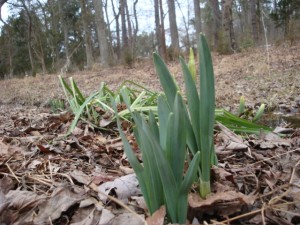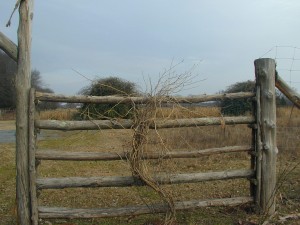by Briscoe White | Feb 17, 2010 | A Year in the Life.., Flowers, Gardening, Growing, Herbs, Indoor Gardening |
We will plant these new beds. So far all we have been able to do is wait, all is ready but the weather. We have big plans for this garden we are calling “ a year in the life”. This cold frame structure is covered with a sheet of construction grade plastic, when spring temperatures are reliably warm we will remove it and cover with a shade fabric which gives about 30% shade and breaks up wind and heavy rainfall. The plastic keeps the inside warm, but not when temperatures are as low as now.
The beds are laid out to give us a demonstration garden for the plants we sell. We will keep a photo record of each planting, we will have flowering annuals and will mix in an assortment of culinary herbs. We hope to keep a bed of medicinal herbs and maybe some aromatic herbs, but would like some input as to what we should plant.
One bed may have a large basil plant surrounded by calibrachoa and celosia, combining herb plants with annual plants. First seeds will be sown in a week or two, as soon as night temps rise out of the twenties. For now I am still stuck talking about what I am going to do, but this has been one rough winter. Not yet, but soon we will have these beds full of plants!

The first daffodils are a sure sign that spring is on its way!
by Briscoe White | Feb 15, 2010 | Flowers, Gardening, Growing |
Working in the greenhouse this weekend, I performed the daily tasks so everyone else could be home. One task is checking the germination chamber twice each day. The seed flats are left in only to the point of germination. The seeds do not sprout at the exact same time. Depending on the seed, they germinate over a range of time from one day to several weeks. So, when the first few seedlings are seen, we move that flat to the greenhouse.
Germinating seeds is more like fun than work. From so little, so many plants spring forth (no pun intended). The germination chamber is great for seeds, but disastrous for seedlings, they quickly stretch and are to weak to stay upright. That is why we check twice a daily, even one day in the germination chamber will ruin seedlings.
The seedlings pictured were my amazement for the day. At 8:00 AM there was no plant life visible in these flats. When I returned at 4:00 PM the tomatoes, moonflowers, and morning glories had all grown to one-inch tall seedling! That is some fast growth!

by Briscoe White | Jan 20, 2010 | Exploring, Flowers, Growing, Life on the Farm |
I planted these yellow flowering Campis vines several years ago. The gate is into our farm orchard, but the Trumpet Creeper was planted so that it would grow up and over the arch and imitate the vine encircling the pages of the first version of The Growers Exhange.com, which is based in the nursery next to this orchard.
Who would have guessed the web-store would grow faster than a Trumpet Creeper? The newer version sacrificed art for function so the vine no longer lives in cyberspace, but should reach the top of the arch this summer here in Charles City. Trumpet creeper grows so well here it can actually be a problem in some places, we chose a yellow hybrid to be a little different from the wild cousins growing in nearby trees.
The plan is to bind the vines to keep it growing a along the fence and up the arch over the gate. Each winter we wrap it with old baling twine to keep a neat column of foliage along the cedar post. Look for a picture this summer when it will be covered in Yellow Trumpet Flowers, which is also it’s name!

by Briscoe White | Oct 28, 2009 | Flowers, Gardening |
Without ever thinking much about it, we were mowing several acres of grass all summer, mainly because it was done that way before we inherited farm management. Being gardeners and growers of garden plants, we were more than happy to replace a grass lawn with anything, especially if we could plant more flowers.
The solution for most of these areas was as simple as moving some fences and let the cows and horses graze the same grass we had been mowing. But the area along the road to the house was not a place we wanted livestock roaming. So, that winter, I tilled the grass and let nature kill the unwanted grass. In early spring I used a seed drill to plant the area with a few pounds of cosmos seed. Cosmos was chosen for several reasons; the seed is inexpensive and gives a huge return for very little effort. It grows tall fast and forms a canopy, which inhibits weed growth. And best of all it blooms from spring until a killing frost ends it for the year. This patch of color can be seen for a long ways off; and the drive itself became a tunnel of color everyone enjoys. We get regular calls from neighbors searching for pink flowers for baby showers, weddings, etc. And because there is so much from so little seed, we can always say, help yourself to all you want.
Being familiar with cosmos, this was all well and good, but held few surprises. It wasn’t until the stand had been killed by frost that we discovered cosmos’s hidden treasure. The patch looked pretty bad, all dead and starting to blow down when I decided to mow it for winter. As I approached the stand on a tractor, a sudden burst of activity and color stopped me from cutting. If there was one, there were two hundred goldfinches fleeing what to them was a bountiful banquet. It turned out that they highly favor cosmos seed and there were several hundred pounds of it on the hoof.
It is true we love flowers for their own sake, but we have always felt birds are an important component of any garden. What we had here was the largest concentration of goldfinches any of us had ever seen. So now, after frost, those dead plants are not so unsightly. We adjust to the changing season and instead of looking for a wall of color, we look for a sudden burst of yellow as the finches dart to the safety of trees. The birds are every bit as exciting as the flowers; and we do enjoy sharing the farms bounty with the birds! While quietly contemplating this garden one realizes how given the chance, life will move in and find something of value, even if we did not see it without a little help from our friends, the goldfinches. I would never mow that patch until it is picked cleaned of seed, it just wouldn’t be neighborly. And we do love our little neighbors, the goldfinches.

by Briscoe White | Oct 23, 2009 | Flowers, Growing |
Of all the plants in one’s garden, there are always a few that become our favorite. Salvia Coral Nymph is one of those plants for me. As everyone knows, there are so many salvias, it hard not to have some in any garden. At the local herb fair The Growers Exchange attended for many years, there was a guy that sold only salvias. He packed everything in a station wagon and attended fairs like this one for no other reason than that he loved salvia, and thought everyone should be able to grow them. So the herb fair was also one’s only chance each year to buy rare salvias for the up coming summer. I was always sure to come home with several.
Coral Nymph is a little more common than some salvia, but one does not see it often. In my travels, I always scan yards and visit nurseries to see what treasures may turn up. It seems to me Coral Nymph is found in pockets, some grower will introduce it to the area, and it becomes a local stand by in local gardens.
For a hot, dry area with full sun, Coral Nymph can produce salmon and white flower stalks from early summer until a hard freeze. The one pictured endured frost two nights ago. Nothing likes to eat it because the foliage has a strong smell when bruised. They grow big, 24- 30 “ in height and the same around. If you are looking for salmon in a sunny place, Coral Nymph is worth trying. And if you like it, it reseeds readily the next year.






